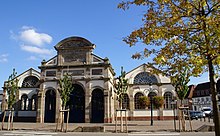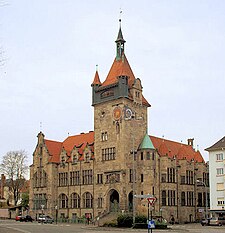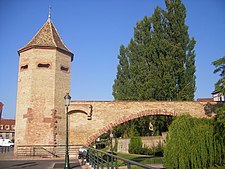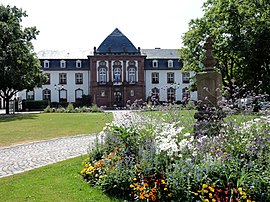|
Haguenau
 Haguenau (French: [aɡ(ə)no] ; Alsatian: Hàwenau [ˈhaːvənau̯] or Hàjenöi [ˈhaːjənœi̯]; German: Hagenau; historical English: Hagenaw) is a commune in the Bas-Rhin department of France, of which it is a sub-prefecture.[3] It is second in size in the Bas-Rhin only to Strasbourg, some 30 km (19 mi) to the south. To the north of the town, the Forest of Haguenau is the largest undivided forest in France. Haguenau was founded by German dukes and has swapped back and forth several times between Germany and France over the centuries, with its spelling altering between "Hagenau" and "Haguenau" by the turn. After the French defeat in the Franco-Prussian War, Haguenau was ceded to the new German Empire. It was part of the German Empire for 48 years from 1871 to 1918, when at the end of World War I it was returned to France. This transfer was officially ratified in 1919 with the Treaty of Versailles. Haguenau is a rapidly growing town, its population having increased from 22,944 inhabitants in 1968 to 34,504 inhabitants in 2017.[4] Haguenau's functional urban area has grown from 54,415 inhabitants in 1968 to 75,933 inhabitants in 2017.[5] History Haguenau dates from the beginning of the 12th century, when Duke Frederick II the One-Eyed (1090 – 6 April 1147) of Swabia erected a hunting lodge on an island in the river Moder. The medieval King and Holy Roman Emperor Frederick I Barbarossa fortified the settlement and gave it town rights, important for further development, in 1154. On the site of the hunting lodge he founded an imperial palace he regarded as his favourite residence. In this palace were preserved the "Crown Jewels of the Holy Roman Empire", i.e. the jewelled imperial crown, sceptre, imperial orb, and sword of Charlemagne. Richard of Cornwall, King of the Romans, made it an imperial city in 1257. Subsequently, through Rudolph I of Germany — the first Habsburg emperor — Haguenau became the seat of the Landvogt of Hagenau, the German imperial advocate in Lower Alsace. In the 14th century, it housed the executive council of the Decapole, a defensive and offensive association of ten Alsatian towns against external aggression, economic expansion and related political instability. In the Peace of Westphalia in 1648, Alsace was ceded to France, which had repeatedly invaded and looted the region in the past. In 1673 King Louis XIV had the fortifications as well as the remains of the king's palace razed in order to extinguish German traditions. Haguenau was recaptured by German troops in 1675, but was taken again by the French two years later, when it was nearly destroyed by fire set by looting French troops. In 1793 Prussians and Austrians had occupied Lower Alsace from the Lauter to Moder to support the Royalists and before the year's end were driven back over the border by the French Revolutionary Army, causing the “great flight”. In 1871, Haguenau was ceded to the German Empire upon its victory in the Franco-Prussian War; the community was made part of Alsace-Lorraine, with its Germanic spelling–Hagenau–restored. The Haguenau Airport was built in 1916 by the German military to train fighter and bomber pilots to fight in the First World War.[6] Hagenau was part of the briefly independent Republic of Alsace-Lorraine after World War I, before being returned to France in 1919. Second World WarIn the Second World War, Germany retook the town in 1940. In November 1944 the area surrounding Haguenau was under the control of the 256th Volksgrenadier Division under the command of General Gerhard Franz.[7] On 1 December 1944, the 314th Infantry Regiment of the 79th Division, XV Corps, 7th U.S. Army, moved into the area near Haguenau, and on 7 December the regiment was given the assignment to take it and the town forest just north that included German ammunition dumps. The attack began at 0645 on 9 December, and sometime during the night of 10 December and the early morning of 11 December the Germans withdrew under the cover of darkness, leaving the town proper largely under American control.[8] Before they withdrew, the Germans demolished bridges, useful buildings, and even the town park. However, as experienced by Haguenau throughout its history, the Germans came back and retook the town in late January. Most of the inhabitants fled with the assistance of the U.S. Army. The Americans launched an immediate counterattack to retake the town.[9] The 313th Infantry Regiment of the 79th Division was relieved by the 101st Airborne Division on 5 February 1945.[10] The 36th Infantry Division would relieve the 101st on 23 February 1945.[11] On 15 March the Allied Operation Undertone, a combined effort of the U.S. Seventh and French 1st Armies of the U.S. Sixth Army Group, was launched to drive the Germans back along a 75 km line from Saarbrücken to Haguenau. The last German soldier was not cleared out of the town until 19 March 1945, after house-to-house fighting. Much of the town had been destroyed despite the Allied reluctance to use artillery to clear out the Germans.[12] Technical Sergeant Morris E. Crain, Company E, 141st Infantry Regiment, 36th Infantry Division was posthumously awarded the Medal of Honor for providing covering fire for his men on 13 March 1945.[13] Population
EconomyThe town has a well balanced economy. Centuries of troubled history in the buffer lands between France and Germany have given Haguenau a rich historical and cultural heritage which supports a lively tourist trade. There is also a thriving light manufacturing sector centred on the industrial zone to the west of the town. Here the presence nearby of significant retail developments testifies to Haguenau's importance as a regional commercial centre. The recent extension of the ring road has improved access to the commercial and industrial zones and reduced the traffic congestion which used to be a frequent challenge for vehicle drivers using the road which follows the line of the old town walls on the western side of town. Sights    ArchitectureIn spite of the extensive destruction Haguenau suffered during the many wars experienced by Alsace, especially the Thirty Years' War, the French conquest in 1677 and the Second World War, it still possesses monuments from nine centuries, even if nothing is left of arguably the most prestigious of them, Frederick I Barbarossa's imperial palace (Kaiserpfalz). Medieval Haguenau retains three gates from its former fortification, the Tour des Chevaliers (Tower of the knights), the Tour des Pêcheurs (Tower of the fishermen) and the Porte de Wissembourg (Wissembourg gate), two fairly large Gothic churches, Saint-Georges and Saint-Nicolas, an ancient water-mill and the old custom-house (Ancienne Douane). Both Saint-Georges and Saint-Nicolas Church have lost many of their artistic treasures over the centuries, especially their medieval stained glass windows and outside sculptures. Still, both display to this day some fine liturgical furniture (altars, choir stalls, organ cases, church tabernacles, calvaries...). Saint-Nicolas has become the receptacle for the baroque wooden decoration of the church of the destroyed Neubourg Abbey nearby. French Baroque and classicism has bequeathed the town several buildings, among which the former hospital and the current town hall. The Synagogue (1820) is a fine example of French Neo-classicism, as is the theatre (Théâtre municipal) (1846). The large Hop hall (Halle au houblon) is a good example of historicism in architecture. It was built by the French in 1867 and extended twice by the Germans, in 1881 and 1908. The Basilica of Our Lady in the locality of Marienthal is a vast Gothic Revival sanctuary (1863–1866). It keeps two early 15th-century statues, and a host of sculptures from around 1519. Haguenau's streets are adorned by attractive fountains, the medieval Saint-Georges fountain, the 18th-century Bee fountain (Fontaine aux abeilles) and the 1825 Dolphin fountain (Fontaine aux dauphins). Museums
Higher educationThe Institut universitaire de technologie de Haguenau (IUT) was founded in 2006. It is a branch of the University of Strasbourg. TransportHaguenau station offers rail connections to Strasbourg, Wissembourg and Niederbronn-les-Bains. Notable people
Twin townsHaguenau is twinned with Landau (Germany). MediaEpisode eight of the Second World War miniseries Band of Brothers is set in Haguenau. In the 1968 film The Girl on a Motorcycle, Marianne Faithfull's character sets out from Haguenau on her fateful journey. See alsoReferences
External linksWikimedia Commons has media related to Haguenau.
|
||||||||||||||||||||||||||||||||||||||||||||||||||||||||||||||||||||||||||||||||||||||||||||||||||||||||||||||||||||||||||||||||||||||||||||||||||||||||||||||||||||||||





